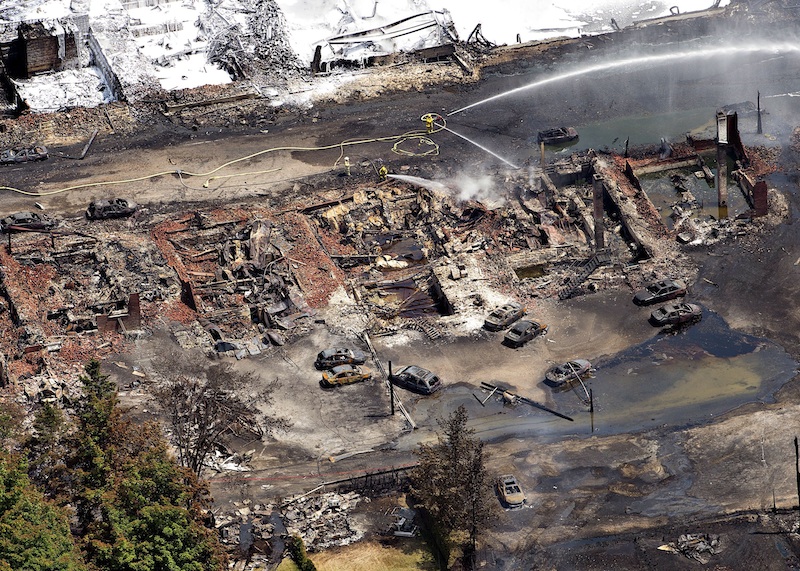LAC-MEGANTIC, Quebec (AP) — Canadian authorities said Tuesday they have opened a criminal investigation into the fiery wreck of a runaway oil train as the death toll climbed to 15, with dozens more bodies feared buried in the blackened, burned-out ruins of this small town.
Quebec police Inspector Michel Forget said that investigators have “discovered elements” that have led to a criminal probe. He gave no details but ruled out terrorism.
Tangled debris and gas leaks hampered rescue workers’ search for bodies three days after the crash early Saturday that incinerated much of Lac-Megantic’s downtown and raised questions about the safety of transporting oil by rail instead of pipeline.
Investigators zeroed in on whether a blaze on the train a few hours before the disaster set off the deadly chain of events.
The death toll rose with the discovery of two more bodies Tuesday. About three dozen more people were missing.
“This is a very risky environment. We have to secure the safety of those working there. We have some hotspots on the scene. There is some gas,” Quebec Provincial Police Sgt. Benoit Richard said.
The bodies that have been recovered were burned so badly they have yet to be identified.
The Montreal, Maine & Atlantic Railway train broke loose early Saturday and hurtled downhill through the darkness nearly seven miles (11 kilometers) before jumping the tracks at 63 mph (101 kph) in Lac-Megantic, near the Maine border, investigators said. All but one of the 73 cars were carrying oil. At least five exploded.
The blasts destroyed about 30 buildings, including the Musi-Cafe, a popular bar that was filled at the time, and forced about a third of the town’s 6,000 residents from their homes.
Rail dispatchers had no chance to warn anyone during the runaway train’s 18-minute journey because they didn’t know it was happening themselves, Transportation Safety Board officials said Tuesday. Such warning systems are in place on busier lines but not on secondary lines, said TSB manager Ed Belkaloul.
Resident Gilles Fluet saw the approaching train just before the derailment and explosions.
“It was moving at a hellish speed,” he said. “No lights, no signals, nothing at all. There was no warning. It was a black blob that came out of nowhere.”
He had just said goodbye to friends at the Musi-Cafe and left. “A half-minute later and I wouldn’t be talking to you right now,” he said.
“There are those who ran fast and those who made the right decision. Those who fooled around trying to start their cars to leave the area, there are probably some who burned in them,” Fluet said. “And some who weren’t fast enough to escape the river of fire that ran down to the lake, they were roasted.”
The same train caught fire hours earlier in a nearby town, and the engine was shut down — standard operating procedure dictated by the train’s owners, Nantes Fire Chief Patrick Lambert said.
Edward Burkhardt, president and CEO of the railway’s parent company, Rail World Inc., suggested that shutting off the locomotive to put out the fire might have disabled the brakes.
“An hour or so after the locomotive was shut down, the train rolled away,” he told the Canadian Broadcasting Corp.
Lambert defended the fire department, saying that the blaze was extinguished within about 45 minutes and that’s when firefighters’ involvement ended.
“The people from MMA told us, ‘That’s great — the train is secure, there’s no more fire, there’s nothing anymore, there’s no more danger,'” Lambert said. “We were given our leave, and we left.”
Transportation Safety Board investigator Donald Ross said the locomotive’s black box has been recovered.
“The extent to which (the fire) played into the sequences of events is a focal point of our investigation,” Ross said, but he cautioned that the investigation was still in its early stages.
The accident has thrown a spotlight on MMA’s safety record.
Before the Lac-Megantic accident, the company had 34 derailments since 2003, five of them resulting in damage of more than $100,000, according to the U.S. Federal Railroad Administration.
Burkhardt said the figures were misleading.
“This is the only significant mainline derailment this company has had in the last 10 years. We’ve had, like most railroads, a number of smallish incidents, usually involving accidents in yard trackage and industry trackage,” he told the CBC.
The tanker cars involved in the crash were the DOT-111 type — a staple of the American freight rail fleet whose flaws have been noted as far back as a 1991 safety study. Experts say the DOT-111’s steel shell is so thin that it is prone to puncture in an accident, potentially spilling cargo that can catch fire, explode or contaminate the environment.
The derailment also raised questions about the safety of Canada’s growing practice of transporting oil by train, and is sure to bolster the case for a proposed oil pipeline running from Canada across the U.S. — a project that Canadian officials badly want.
Efforts continued Tuesday to stop waves of crude oil spilled in the disaster from reaching the St. Lawrence River, the backbone of the province’s water supply. Environment Minister Yves-Francois Blanchet said the chances were “very slim.”
Also Tuesday, Lac-Megantic’s mayor said about 1,200 residents were being allowed to return to their homes.
___
Associated Press writers Rob Gillies and Charmaine Noronha in Toronto, Jason Keyser in Chicago James MacPherson in Bismarck, N.D., contributed to this story.
Copyright 2013 The Associated Press.









